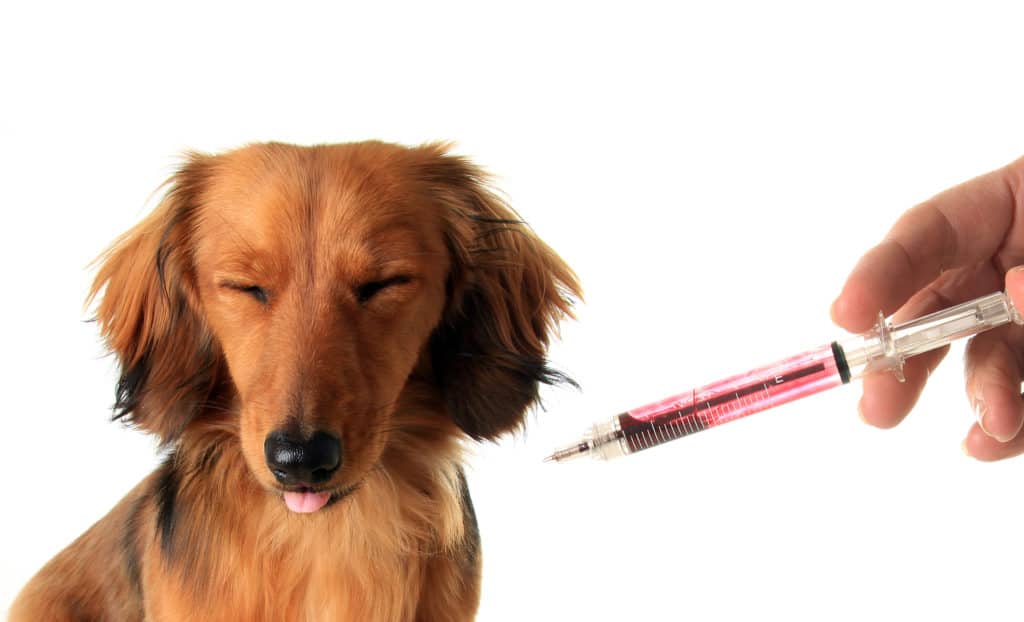
- A Guide to Understanding IVDD Disease in Dachshunds
- What is IVDD in dachshunds?
- What Causes IVDD in Dachshunds?
- What breeds of dogs can get IVDD other than the dachshund?
- Different types of IVDD in dachshunds:
- What are the signs and symptoms of IVDD in dachshunds?
- How is IVDD diagnosed in dachshunds?
- Can dachshunds recover from IVDD?
- Tips for preventing IVDD in Dachshunds
A Guide to Understanding IVDD Disease in Dachshunds
One of the scariest diagnoses heard in a veterinary office is that your Dachshund has IVDD. This disease is very serious and can have serious consequences in your Doxie’s life.
IVDD is very common in dachshunds. It occurs when dachshunds develop inflammation or degeneration that causes their intervertebral disc to leak, herniate, bulge, and protrude through the protective membrane surrounding it (called annulus fibrosis).
If you are reading this article because your Dachshund has been diagnosed with IVDD here are some questions to ask your veterinarian: What can I do for my dog? How will naturally heal itself if left alone? Will surgery be necessary?
What is IVDD in dachshunds?
Intervertebral Disc Disease (IVDD) is a degenerative disease in which the spinal discs in the dog’s vertebrae bulge or burst. Bulging or burst intervertebral discs can enter the spinal cord space and put pressure on the spinal nerves. This can cause difficulty walking, pain, nerve damage, and even lower-body paralysis.
What Causes IVDD in Dachshunds?
Although it is a gradual and degenerative disease, it can remain latent for many years. This condition manifests itself when there is an acute injury to the spine that causes pain and mobility deficits.
These injuries usually occur when dachshunds go up or downstairs or try to jump up onto the couch.
The spinal cord is unable to function to its normal capacity due to a herniated disc, and 80% occurs in the thoracic (middle) region of the spine.
What breeds of dogs can get IVDD other than the dachshund?
IVDD is very common in dachshunds due to its physical form. Their long backs and short legs make this breed susceptible if they suffer a spinal injury and thus trigger a case of IVDD.
Although dachshunds are the breed best known for developing the disease, other breeds can also develop this type of disease. Generally, the initial onset occurs between 3 and 6 years of age. The list of breeds included is:
- Bassett hounds
- Beagles
- Bulldogs
- Corgis
- Cocker Spaniels
- Pekingese
- Poodles
- Shih Tzus

Different types of IVDD in dachshunds:
There are two types of intervertebral disc disease (IVDD).
Type 1 IVDD
The first (type 1) is characterized by the rupture of the middle part of the disc (the nucleus pulposus) through tears in the external part of the disc (the annular fibrosis).
This is also known as a “slipped” disc. This type of disc disease occurs as a consequence of abnormal degeneration of the nucleus pulposus, where it loses its normal water content and becomes firm or “calcified.”
The calcified disc material can be seen on plain X-rays in some dogs. This type of disc disease is characterized by a sudden inability to walk and can occur anywhere along the length of the dog’s spine.
About 80% of disc diseases occur in the center of the dog’s back. Type 1 IVDD happens mostly in small dogs, like the Dachshund, Pekingese, Shih Tzu, Toy or Miniature Poodle, Cocker Spaniel, Basset Hound, Chihuahua, and Beagle.
However, it can occur in some large breed dogs, such as the Labrador Retriever, German Shepherd, Dalmatian, Pit Bull Terrier, and Rottweiler.
This type of herniated disc most commonly occurs in young and middle-aged dogs.
Type 2 IVDD
Type 2 IVDD is caused by a chronic bulging of the outer part of the disc in the spinal cord. The condition is typically progressive and may or may not be painful.
It occurs frequently in middle-aged, and older dogs of larger breeds. Chronic spinal cord compression with this type of disc disease often causes spinal cord atrophy.
Click here to read this related post: How to Prevent Dachshund Back Problems
What are the signs and symptoms of IVDD in dachshunds?
As dachshund owners, we are aware of the normal behaviors of our pets. When the typical movements and habits of our pets become abnormal, we should be alarmed.
Signs and symptoms of IVDD:
- Discomfort when moving
- Decreased barking
- Crying when attempting to move
- Sensitivity to touch
- A deficit in the ability to walk
- A hunched back
- Muscle spasms
- Dragging of the back paws when walking.
As the disease progresses, the most associated signs and symptoms may include:
- Intense pain
- Inability to walk
- Bowel and bladder incontinence
- Decreased appetite
- Loss of sensation in the feet
- Mild loss of motor function
- Reduction of the level of activity. (unwillingness to jump or even stand up)
- Hind leg weakness or incoordination.
- Paralysis; dragging one or both hind legs when walking.
- Crying or moaning, especially when moved or touched.
- Muscle spasms and stiffness in the neck or back.
- Bowed or hunched back (a sign of cervical disc problem)
- Reduced appetite
The appearance of an arched back indicates that the dog may be trying to take pressure off the spine and disc.
Click here to read this related post: How to Care for a Dachshund with a Back Injury
Stages of IVDD
- Stage 1: The dog is in pain but still has no difficulty moving.
- Stage 2: The dog can walk but stumbles, and lacks coordination.
- Stage 3: The dog cannot walk but can move its legs.
- Stage 4: The dog has paralysis but can feel pain.
- Stage 5: The dog has paralysis and has lost all sensation in the back legs.
Click here to read more about IVDD in dogs

How is IVDD diagnosed in dachshunds?
A veterinarian will diagnose the animal through a physical exam and other non-invasive tests.
- Myelography: A dye is injected into the spinal cord with X-rays to look for problems in the spinal canal.
- X-rays of the spine: A photographic or digital image of the internal composition of the body
- Magnetic Resonance Imaging (MRI): MRI Is an imaging technology that uses radio waves, and a computer to make detailed pictures of the inside of the body.
- Computerized Tomography Scan: CT scan uses computers and rotating X-ray machines to create cross-sectional images of the body
- A comprehensive neurological examination can be performed by a neurologist with manual palpation and testing.
Can dachshunds recover from IVDD?
Yes, dogs can recover from IVDD. When surgical intervention is not necessary, other treatments can be used to help your dog begin his recovery journey.
Bed rest can help reverse IVDD or minimize signs and symptoms. The use of pain relievers, safe exercise, and supportive care can be used to start your dog’s recovery plan.
The decision to treat IVDD with medication or surgery depends on many factors. Including the speed of onset and progression of the disease, the stage of the disease, and response to medication.
Medical Therapy
Medical therapy is often successful in dogs who have back pain or mild ataxia and can still walk under their power.
Medical management of acute disc extrusion requires strict confinement for 3-4 weeks, which many dogs are unable to tolerate so they must be medicated heavily with sedatives until full recovery from the procedure.
Dogs may be confined to a large crate, playpen, or small room without any furniture like an empty laundry closet where there won’t be anything that could cause them injury if they jump around too much after surgery.
Surgery
Surgery is often necessary for the successful treatment of IVDD. In some cases, surgery can be avoided if a patient has only mild back or neck pain (Stages 1 or 2) and does not have any paralysis yet.
Surgery is needed in paralyzed patients in Stages 3 to Stage 5 and in patients that can still walk but, experience ongoing back or neck pain, despite appropriate medical therapy.

Tips for preventing IVDD in Dachshunds
- Keep your dachshund’s weight within a healthy range.
- Limit your dachshund’s jumping and climbing. Use ramps for the sofa, bed, and stairs.
- Minimize your pet’s running activities, especially at fast speeds to chase a ball or squirrel.
- Use a harness instead of a neck collar to minimize stress on your neck.
- Avoid tug-of-war play activities that stress your neck and spine.
- If your dachshund shows signs and symptoms of IVDD, you should call your vet immediately.
Click here to see our pick of the best ramps for dachshunds
IVDD is a terrible disease, but by understanding more about it you can know to help your Doxie live a long and happy life.
We want you to be able to spot signs of IVDD as soon as possible so we’ve included some things that might indicate your dog has this condition.
You also need to know how serious the disease is before deciding on treatment options for your pup because there are many different ways they can treat it with varying degrees of success depending on what stage their symptoms are at when they’re diagnosed. It’s better if you catch them early!
If any of these sound familiar in regards to your Dachshund, please call or visit your vet right away!
Related post: Dachshund Back Problems and How to Avoid Them
If you want to find the best pet insurance for your dachshund click here
Recent Posts
Calculate the perfect food portions for your dachshund with our specialized calculator. Get customized feeding recommendations based on size, age, and activity level to support your wiener dog's back...
Looking for the perfect gift for a proud dachshund mom? We’ve rounded up the cutest dachshund shirts that celebrate your love for wiener dogs in style. Whether you’re shopping for yourself or a...


